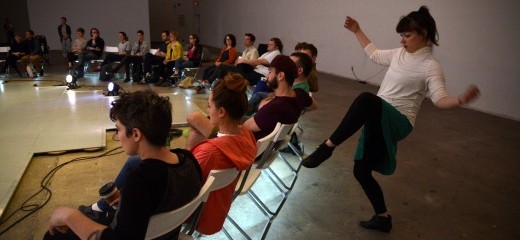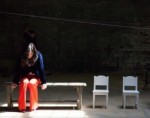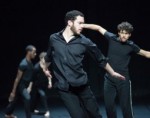
The Container and the Contained
by Anna Drozdowski
The anti-chamber to the performance space at the CraneArts building is spare. Televisions deliver slivers of life recorded at 3:15pm: Meg Foley’s improvisational dance practice occurs daily at this time and is translated into the gallery with words, photos, and clips curated by Marissa Perel. Accompanying the moving images are broadsheets penned by Laura Neuman and process journals from the performers—some excised for concision, others for privacy. But it is the very proximity between “living” and “performing,” between “being” and “dancing,” that the project foists at us. Action is Primary rides the slippery space between proscenium performance and visual art installation, simultaneously breathing into and being boxed in by the white cube.
Skimming through six months of process rarified both by presentation (lack of vitrines) and access (please look and touch) we’re casually invited through the cast iron threshold into the Icebox, a former fish-packing plant. Whiteness surrounds us in the enormously pristine space—a cavernous canvas, plain like yogurt, a little sour and hard, not vanilla. The 3x5” title card is blown up beyond human scale for this 4D part of project. Instead of cataloguing physical materials, the imposing wall of information offers a six-element score. The work we’ll encounter will be built in real time through these materials.
Rounding the imposing wall of formality, I try to hold onto the pieces of the score so that I might identify them the same way I pick out cardboard, gouache, or watercolor. I fixate on “authentic melodrama,” and wonder if it will be easy to hold like one of Sol Lewitt’s wall drawing instructions, precise and simple yet producing surprising results.
Chairs demarcate the performance area, pushed off into the far corner. Foley explains that they’ve arranged the floor to approximate the shape of the rehearsal studio, keeping the custom of a practice-based experience in performance. I fixate on the twelve-inch concrete boundary between my feet and the start of the “playing space.” The formality of the structure belies a performance form (improvisation) that I’ve known to be approachable in the past. I am clearly an observer here; the white-on-white chairs become the rope around the installation which consists of the corner, two dozen interlocking panels, and one, live, 30-year-old Annie Wilson.
She begins in near darkness, and it is difficult to pick out her actions in the suddenly soft grey room which envelopes her quick-changing directional patterns in a fuzzy haze. I feel the sharpness more than see it, but know it is there. Following Wilson to the lighting console, we learn that she will control each decision that will be made, including the atmosphere. Some choices she’ll describe to us, and some will be our duty to engage with independent of annotation. “Authentic Melodrama” stands out from this horizontal canvas and screams, just as she does. “Everything at Once” is as chaotic and harried as I imagined. Both verbally and physically Wilson is, at times, terrifyingly apoplectic in her actions but committed to riding them out to their honest conclusion.
This is the opening salvo of a series of performances accompanying the installation—each of them at night, with a rotating cast presenting the same six-point material for two viewings during the evening. When Wilson opens an external door I gulp for springtime air as she also catches her breath, still reeling from the embarrassment of the three-foot long crack in the plaster she initiated, accidentally, in the first few moments of her dance. She has broken the hermetic seal between the pristine performance space and the lush urban landscape (read: weeds), and she has broken the cube itself—destroyed equally by the birdsong she’s just allowed in, as well as the back of her arm.
I am watching a sculptor. Carving space and time, Wilson improvises through a series of instructions: each begets an action that necessitates her attention to the audience. I am struck by her magnetism, so loud it almost vibrates. Wilson commands notice cleverly and authentically, whittling time from time and from the surrounding space. In this intimate audience, it is impossible to be distracted; my attention is reeled in by the solo set against the backdrop of other eyes. There are some performers (as there are some paintings, some sculptures, some accumulation of materials) that damn near dare you to look away while in their presence.
This will be the litmus against which all future performances will be compared. Annie’s Dance (first name, familiar, singular, possessive) has become my bellwether, and the installation falls away—eaten by her presence. The sterile room spills over with the possibilities of moving bodies; in front of us a rarified example commandingly navigates through an unpredictable path. The score is stable, the possibilities ever surprising.
“We haven’t worked out the intermission yet,” she calls over her right shoulder, jogging ceaselessly in circles. “So I’ll just keep doing this until you leave for a ten minute break, sound okay?”
Not a single person moves.
There is a guilty pleasure in witnessing exhaustion begin to set in.
But we are kind, and there is wine to drink back in the gallery—now reduced to a mere lobby. The force of Wilson’s performance leaves an indelible mark on this installation, a trace that resonates. Even in its absence, the action in the far corner stays with me well beyond the intermission, beyond the second act, beyond the evening, beyond the website.
It is aptly called primary. It remains.
Action is Primary, Meg Foley and collaborators Kristel Baldoz, Marysia Stokłosa, and Annie Wilson, Icebox Project Theater at Crane Arts, April 6-23. http://www.actionisprimary.com
Read Jenna Horton's understanding of the project here.
By Anna Drozdowski
May 24, 2016






.png)


